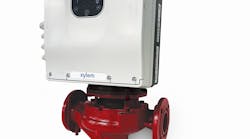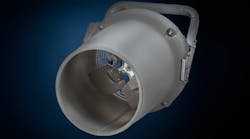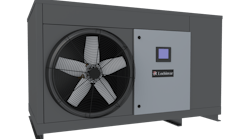Humidity control is a critical aspect of treating air for air conditioning and air used in manufacturing or other non-standard processes. Moisture affects building materials, the comfort of building occupants, and, in many cases, the work performed in the facility — particularly if the function of the building is the handling and processing of hygroscopic materials. Given its importance, humidity is ironically one of the more misunderstood aspects influencing the internal environment of a building.
Misconceptions arise from the fact that the impact of humidity on environments, people, and processes is a function of non-linear relationships among temperature, moisture content, pressure, and elevation. These relationships are best illustrated using the science of psychrometrics. A book by Donald P. Gatley, PE, provides an excellent primer on psychrometric science and engineering.1
A primary concern with dehumidification-system design is energy consumption. The majority of the energy expended for dehumidification is for the removal of moisture from the air stream because condensing moisture out of the air is a change in the state of the vapor. Cooling 1 lb of water 1°F requires approximately 1 Btu of energy while condensing 1 lb of water vapor to water takes approximately 1,000 Btu.
TYPICAL SYSTEMS
Dehumidification is accomplished in a variety of ways. The method used often is dependent on the specific temperature and humidity conditions required in the space and the climate conditions at the site. The systems used in a specific application are chosen based on their effectiveness and efficiency in achieving the desired conditions. In addition, a life-cycle cost analysis that compares the first cost, operating costs, and maintenance costs are applied. Typical methods of dehumidification include the application of cooling, liquid and solid desiccants, and compression.
Cooling
The most common method of dehumidification is the use of cooling coils. This method typically involves a coil in an airstream with a fluid circulated through the coil at a temperature below the dew point of the air stream. The amount of moisture removed is relative to the temperature of the fluid (and coil). Typical fluids used are chilled water, refrigerants, glycol solutions, or engineered fluids. Because the coil temperature is below the dew point of the air stream, the moisture that condenses on the cooling coils is collected in a pan and removed.
With the current trend toward greater sustainably, this water can be reclaimed for a variety of uses, such as for makeup for cooling towers, lawn irrigation, or toilet flushing. One manufacturer has a dehumidification unit that yields drinking water. The corresponding reduction in water use can contribute to the certification of green buildings under the U.S. Green Building Council's LEED rating system.
Because this method also reduces the temperature of the HVAC-system supply air, there is the possibility that the spaces served could be subcooled if the rooms do not have sufficient internal heat gain to offset the low-temperature air. This traditionally has been accomplished with reheat coils that maintain space temperature, which can represent a significant energy-cost penalty, depending on the conditions to be attained. Applications that require air temperature to be driven down for dehumidification purposes, but do not require the amount of cooling, can be provided with a heat-pipe run-around system.
These systems consist of coils on either side of the cooling coil and use a refrigerant to economically pre-cool and reheat the air stream. For more information about these types of systems, read the three-part article in HPAC Engineering by Donald P. Gatley, PE.2
Liquid-desiccant systems
Desiccant dehumidification systems often are used where the dehumidification requirement is greater than the cooling requirement. One type, the liquid desiccant system, involves spraying a liquid desiccant solution (typically, lithium chloride) through an air stream, where it absorbs moisture from the air stream and provides some cooling. The exact conditions can be varied by changing the concentration of the lithium-chloride solution. One benefit of using systems such as this is that the desiccant solutions act as a biocide for the conditioned air, which is beneficial in applications for which bacteria or viruses are least desirable. The solution then is regenerated by heating it, where it loses its moisture before spraying it across the air stream again. A hot, moist waste-air stream also is exhausted from the regenerator.
Solid-desiccant systems
Another type of dehumidification approach employs a solid desiccant, such as silica gel. Moist air is drawn through the desiccant, which absorbs moisture. As the desiccant reaches its capacity, it is moved into a warmer air stream (called the reactivation air stream), where it rejects the moisture before it is exposed to the moist air stream again. This often is accomplished by running supply air through a desiccant wheel. Solid desiccants need to be regenerated, which can be accomplished using waste heat or an exhaust air stream.3
Compression
Some process systems use compression as a means of reducing the absolute moisture of the air. Compressing air reduces its ability to hold moisture, so water condenses once the air is compressed to its saturation point. This is the first stage of dehumidification for a process such as an instrument air and usually is followed by additional dehumidification (coil or desiccant) so air is not saturated.
ON THE HORIZON
Still in the laboratory, but possibly coming soon, is a new technology called electrostatic dehumidification, which uses electrostatic fields to separate moisture vapor from air streams so that only the portion of air with less water vapor is used in the process. This is particularly exciting because of the possibility to significantly decrease the energy used for dehumidification by eliminating the need to cause water to change state from a vapor to a liquid. Depending on the specific application, this approach may become an attractive alternative to the other, more traditional methods outlined above.
REFERENCES
-
Gatley, D.P. (2002). Understanding Psychrometrics, American Society of Heating, Refrigerating and Air-Conditioning Engineers, Inc., Atlanta.
-
Gatley, D.P. (2000, September, October, November). “Dehumidification Enhancements for 100-Percent-Outside-Air AHUs,” HPAC Engineering.
-
Harriman, L. (June 2003). “20 Years of Commercial Desiccant Systems,” HPAC Engineering.
As the director of mechanical services for Kling, Charles A. Rowland, PE, LEED AP, is responsible for all aspects of the design of HVAC, process, plumbing, and other mechanical systems. As an engineering design principal at Kling, Martin J. Wendel Jr., PE, is responsible for engineering leadership and supervision of all mechanical-services disciplines, including HVAC, process plumbing, fire protection, and instrumentation and controls on company design projects.









